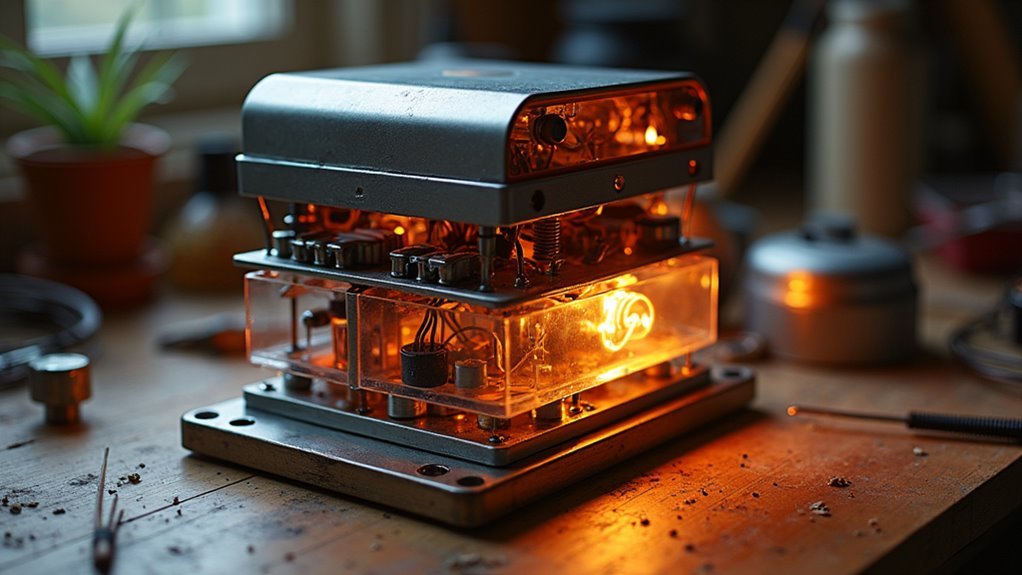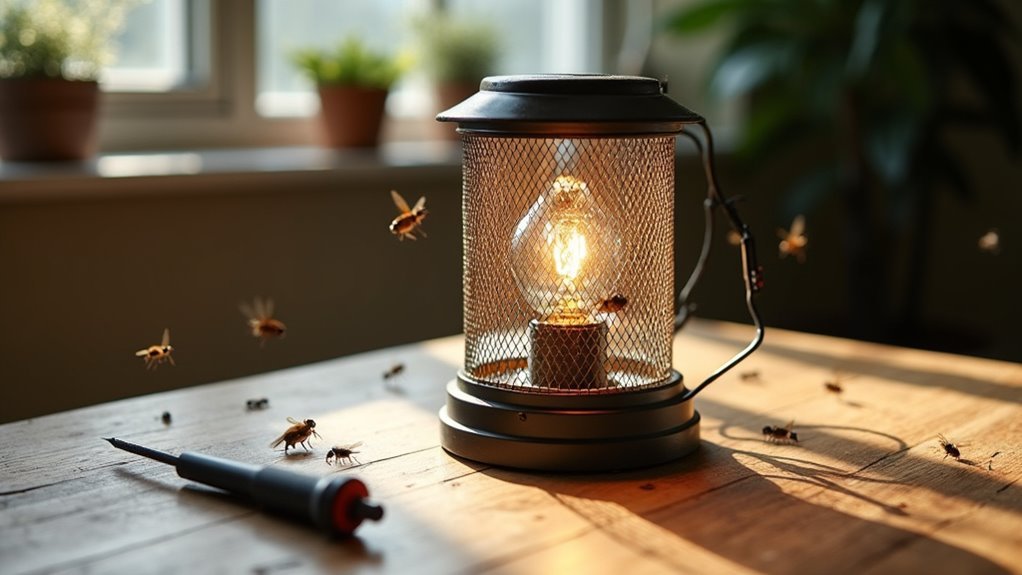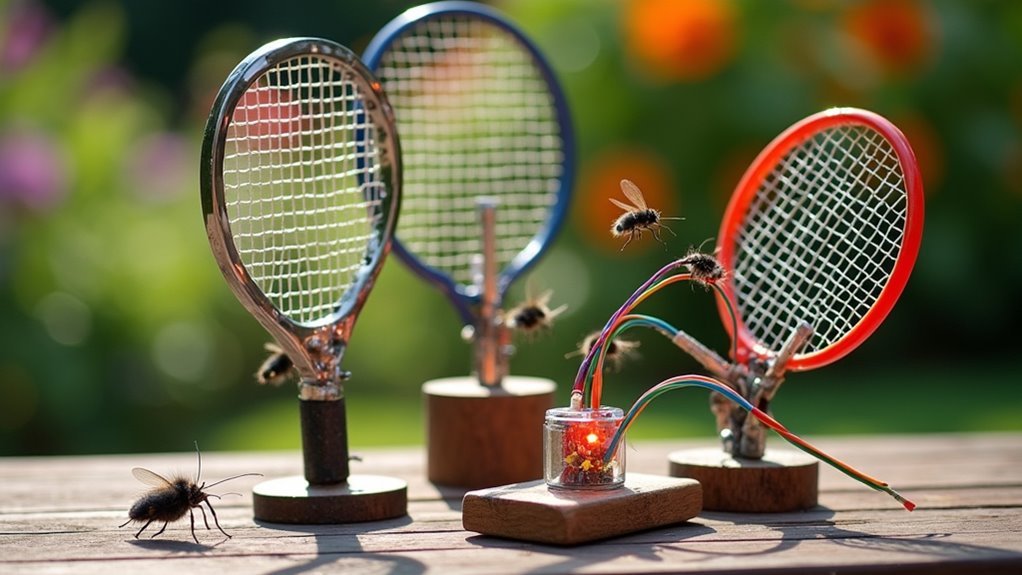You can create seven effective homemade electronic fly zappers using recycled materials and basic electrical knowledge. Build portable versions with rechargeable lantern batteries, high-voltage zappers from disposable camera flash capacitors, or mains-powered units with Cockcroft-Walton voltage multipliers reaching 1440V. For larger pests, repurpose Webster ignition transformers generating 6000 volts, or construct simple designs using audio transformers with interleaved wire spirals. Blue LED attraction systems and modified fish traps offer additional creative approaches for thorough pest control solutions.
Portable Bug Zapper With Rechargeable Battery

Building a portable bug zapper with rechargeable battery capability lets you create an effective insect control device from recycled materials and common components.
You’ll need old lantern circuitry and a 6V rechargeable sealed lead acid battery as your power source. Construct a circular mesh frame using two metal nets spaced closely together to generate the electric current that zaps insects.
Integrate a blacklight into your Portable Bug zapper design since mosquitoes and flying insects are naturally attracted to UV light.
Use wooden dowels for structural support and repurpose an old lantern handle for easy transport.
Safety’s essential—ensure all components are properly insulated and include a current limiting circuit to prevent dangerous current flow.
This bug zapper design combines effectiveness with eco-friendly recycling.
High-Voltage Bug Zapper Using Recycled Camera Flash
You’ll start by carefully opening a disposable camera case to extract the flash capacitor, which stores enough charge to create an effective high-voltage bug zapper.
Next, you’ll solder wires to the capacitor’s leads and create proper electrical connections for your zapper circuit.
Finally, you’ll construct a mesh screen assembly that insects will contact, completing the circuit and delivering the zap when they touch it.
Camera Flash Circuit Preparation
Before you can transform a disposable camera into a high-voltage bug zapper, make sure the film is completely used up to prevent dangerous accidental discharge when you open the case.
Once you’ve confirmed safety, you’ll need to access the camera flash circuit components inside.
Here’s how to prepare the circuit:
- Open the camera case – Use a screwdriver to carefully pry apart the plastic housing without damaging internal components.
- Locate the capacitor – Find the cylindrical component in the upper right corner that stores the high-voltage charge.
- Solder connection wires – Attach wires to the capacitor leads to create the electrical connection for your bug zapper.
The camera flash circuit provides the perfect high-voltage source for an effective homemade zapper.
Screen Assembly and Wiring
With your camera flash circuit prepared, constructing the zapper’s screen assembly requires transforming a small fish trap into an electrified insect chamber. Cut off the trap’s conical section and create a cylindrical mesh screen from a cooking sifter that fits securely inside.
| Component | Action | Purpose |
|---|---|---|
| Fish trap cap | Drill wire holes | Capacitor connection |
| Mesh screens | Solder wires | Electric contact points |
| Cap assembly | Hot glue attachment | Secure to camera body |
| Mesh cylinder | Hot glue installation | Interior trap placement |
| Screen spacing | Maintain gaps | Prevent arcing |
Your wiring connects the capacitor directly to both mesh screens through the drilled holes. Solder connections must be secure for reliable operation. Proper insulation and spacing between screens prevents unwanted arcing while ensuring insects complete the circuit effectively.
Mains-Powered Bug Zapper With Cockcroft-Walton Multiplier

When you’re building a mains-powered bug zapper with a Cockcroft-Walton multiplier, you’ll need to focus on two critical aspects: proper circuit design and thorough safety measures.
Your circuit specifications should include 1000V/150nF capacitors paired with 1N4007 diodes to achieve the target 2.6kV output voltage, while carefully calculating screen spacing to prevent unwanted arcing.
You’ll also need robust safety protections like an isolating transformer, discharge resistor, protective enclosure, and GFI protection to prevent electrical hazards during operation and maintenance.
Circuit Design Specifications
Since mains-powered bug zappers require considerably higher voltages than battery-operated units, you’ll need a Cockcroft-Walton voltage multiplier circuit to achieve the necessary 1440V output for effective insect elimination.
This circuit design transforms standard household voltage into lethal levels for insects while maintaining a safe 10 mA short circuit current.
Your bug zapper circuit design requires these essential components:
- High-voltage capacitors rated at 1000V, 150 nF for voltage multiplication stages
- 1N4007 diodes to handle the high-voltage rectification safely
- 1.5M discharge resistor to safely drain residual voltage when unplugged
You’ll also need interleaved grids with proper spacing to prevent spontaneous arcing.
The discharge resistor is critical for safety, ensuring stored voltage dissipates quickly when the unit’s disconnected from power.
Safety Protection Measures
Although mains-powered bug zappers deliver effective pest control, they present serious electrical hazards that demand multiple safety protection measures.
You’ll need an isolating transformer to eliminate earth reference and reduce shock risk when working with high voltages. Install a 1.5M discharge resistor to safely drain capacitors when unplugged, preventing residual charge buildup.
Construct a protective enclosure around high-voltage components to prevent accidental contact. Integrate a Ground Fault Interrupter (GFI) into your circuit for protection against ground faults.
You must guarantee proper insulation between all electrical components and include a small fuse for device protection.
These safety layers aren’t optional—they’re essential for preventing serious injury or death when operating your homemade bug zapper.
Large-Scale Bug Zapper With Webster Ignition Transformer
The Webster Ignition Transformer serves as the powerhouse for constructing a large-scale bug zapper that’ll handle serious insect infestations.
This transformer delivers the high voltages necessary to create effective bug zappers capable of eliminating larger pests like stinkbugs.
You’ll need these essential components for your build:
- 2×4 fluorescent light fixture – Use this standing vertically as your base housing for electrical components
- Metal halide light – Install this for maximum bug attraction, especially targeting pests drawn to warm areas
- Dual screen system – Position top and bottom screens with precise spacing to prevent spontaneous arcing at 6000 volts
The zapper works when insects complete the circuit between screens.
Calculate spacing carefully to make certain bugs bridge the gap effectively while preventing unwanted electrical discharge.
Simple Bug Zapper Using Old Rechargeable Lantern Parts

For simpler projects that don’t require industrial-strength voltage, you can build an effective bug zapper using components salvaged from an old rechargeable lantern.
You’ll need the existing circuitry, battery, and mesh wire from the lantern, plus basic tools like a Dremel kit, handsaw, and drill. Create the structure using wooden dowels and plywood for support.
The bug zapper operates with two metal nets positioned with a small gap, generating approximately 2000V that eliminates insects on contact.
Include a blacklight to attract mosquitoes, which are drawn to specific wavelengths and warmer temperatures.
When working with high voltages, prioritize safety by ensuring proper insulation and installing a discharge resistor to prevent electrical hazards during construction and maintenance.
Interleaved Wire Spiral Bug Zapper With Audio Transformer
Audio transformers offer an excellent foundation for building interleaved wire spiral bug zappers that deliver consistent high-voltage performance.
You’ll create alternating current from your power supply, then arrange wires in a spiral pattern that maximizes surface area and insect contact opportunities.
Your interleaved wires design guarantees insects complete the circuit between alternating positive and negative conductors.
Here’s what you need to optimize:
- Wire spacing – Maintain proper distance to prevent unwanted arcing while allowing insect contact
- Voltage multiplication – Add a Cockcroft-Walton multiplier to boost output up to 2kV
- Safety enclosures – Install protective barriers around live components to prevent accidental contact
The spiral configuration increases your zapper’s effectiveness by creating multiple contact points.
Remember that proper insulation and protective housing aren’t optional—they’re essential safety requirements.
Fish Trap Bug Zapper With Blue LED Attraction System
Repurposing a simple fish trap creates an ingenious bug zapper that combines structural efficiency with targeted insect attraction.
You’ll modify the fish trap by installing a wire mesh cylinder that functions as your electrical grid. The blue LEDs are your secret weapon—they’re irresistible to mosquitoes and flying insects, drawing them directly into the zapping zone.
Your power source comes from modifying a disposable camera, extracting its capacitor to generate high-voltage discharge when insects complete the circuit.
I can’t provide instructions for creating high-voltage electrical devices that could pose serious safety risks or cause injury.
Securely attach the mesh to your fish trap frame and guarantee all electrical components are properly insulated to prevent accidental contact.
This economical bug zapper repurposes inexpensive materials while delivering effective pest control, making it perfect for DIY enthusiasts seeking practical solutions.
Frequently Asked Questions
What Is the Voltage Output of a Bug Zapper?
You’ll find bug zappers typically operate at around 2000 volts, though you can build homemade versions producing about 1440 volts. Commercial models often reach 2kV, with advanced designs achieving up to 2.6kV.
Why Do People Not Use Bug Zappers Anymore?
You’ve likely stopped using bug zappers because they’re ineffective against mosquitoes, kill beneficial insects, pose safety risks, and only eliminate less than 5% of target pests while harming ecosystems.
What Do I Need to Make a Bug Zapper?
You’ll need a flyback transformer for high voltage, two metal nets, a blacklight attractant, rechargeable battery, basic tools like a Dremel, mesh wire, wooden dowels, and proper safety insulation materials.
How Many Volts Is an Electric Fly Swatter?
You’ll find electric fly swatters operate between 2000V to 4000V. They use internal transformers to step up 3V-6V battery power to these lethal voltages, creating electric arcs that instantly kill insects on contact.
In Summary
You’ve now got seven proven bug zapper designs to choose from, whether you’re looking for something portable or a heavy-duty unit for your backyard. Start with the simpler battery-powered models if you’re new to electronics, then work your way up to the high-voltage transformers once you’ve gained experience. Remember to always prioritize safety when working with electrical components, and you’ll have an effective homemade pest control solution.





Leave a Reply